Real Estate Market Report: 1st Quarter 2018 – Northern New Jersey
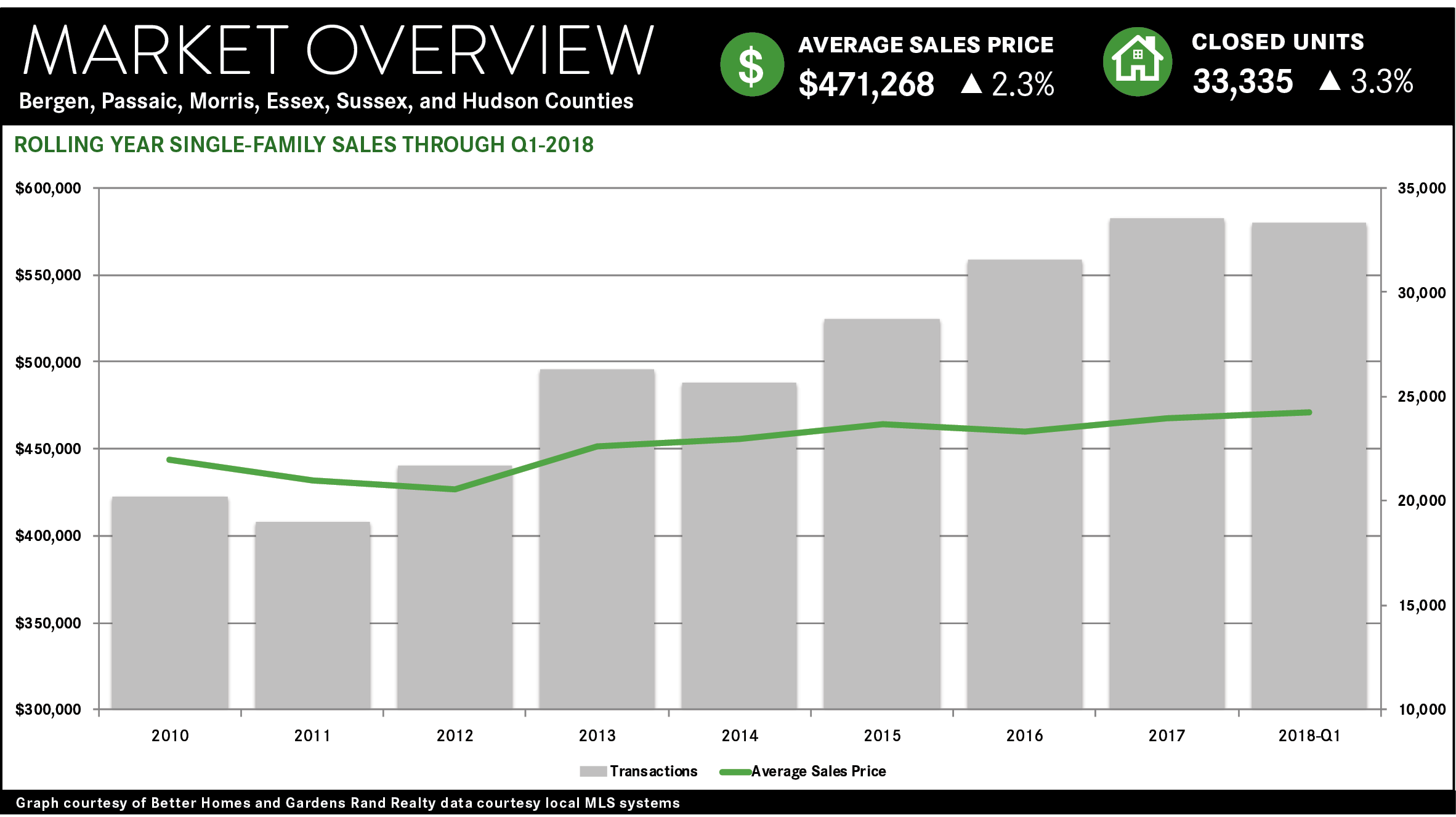
 The housing market in the Northern New Jersey suburbs of New York City has become a fully‑realized seller’s market, with declining inventory stifling sales growth while driving meaningful price appreciation throughout the region.
The housing market in the Northern New Jersey suburbs of New York City has become a fully‑realized seller’s market, with declining inventory stifling sales growth while driving meaningful price appreciation throughout the region.
The regional market continues to suffer from a lack of inventory. The number of homes available for sale compared to last year fell sharply in every market in the region. At the current absorption rate, we are now down to well under six months of inventory in every county for single‑family homes (other than Sussex), which usually denotes a seller’s market.
This lack of inventory is holding back sales. While regional transactions were up 3% for the year, they were down over 3% for the first quarter, and quarterly sales fell in most of the counties. We saw this most acutely in Bergen, where quarterly condo sales were down over 13%, and in Hudson County, where sales fell over 7% for single‑family and multi‑family homes, and over 10% for condos. But this isn’t a demand problem ‑‑ demand is strong everywhere in the region. This is more of a supply problem ‑‑ we simply don’t have enough “fuel for the fire.”
But with all this demand chasing fewer homes, prices are up significantly across the region. The regional average sales price was up over 5% in the quarter, rising for every county and property type, particularly in the markets closest to the city: Bergen was up 1% for single‑families and 19% for condos, and Hudson was up 6% for single‑family, 21% for multi‑family, and 11% for condos. This type of double‑digit appreciation is not sustainable, but the long‑term trend for the rolling year is still very positive, up about 3% for the region and rising in every county except Sussex.
Going forward, this is what a seller’s market looks like. Low levels of inventory will continue to hold sales back even while driving prices up. At some point in 2018, this price appreciation will attract more sellers into the market, which will increase supply, bring sales up, and maybe moderate price increases. But that will not happen right away, so we expect a spring market with even lower levels of inventory, which will stifle sales growth but continue to drive robust price appreciation.
To learn more about Better Homes and Gardens Real Estate Rand Realty, visit their website and Facebook page, and make sure to “Like” their page. You can also follow them on Twitter, Pinterest, and Instagram.
Better Homes and Gardens Rand Realty to Hold Open-House Event

 NANUET, NY – Better Homes and Gardens Rand Realty is excited to announce that they will be holding an open-house event, where attendees can receive advice on buying and selling homes. It will take place on Saturday, April 14, and Sunday, April 15, from 12:00-4:00 p.m. on both days.
NANUET, NY – Better Homes and Gardens Rand Realty is excited to announce that they will be holding an open-house event, where attendees can receive advice on buying and selling homes. It will take place on Saturday, April 14, and Sunday, April 15, from 12:00-4:00 p.m. on both days.
“We’re a few weeks into spring, which means it’s the prime season for the housing industry,” said Denise Friend, Rand Realty’s regional manager for Westchester County. “Our brokerage receives many potential clients during this time of the year, and we would like to offer them guidance on how to achieve their real estate goals.”
All 27 of Rand Realty’s sales offices will be participating in the event, with listings located throughout the Lower Hudson Valley and Northern New Jersey. At these sites, attendees can engage with an agent for one-on-one assistance on how to conduct a home search or market their home for sale. They will also have the opportunity to enter a raffle to win a gift basket, with one being provided by each of the four regions that Rand Realty serves: Rockland, Orange, and Westchester Counties in New York, and Northern New Jersey.
“Being involved in a real estate transaction can be challenging, so it’s important for us to interact with buyers and sellers to make sure that their questions are being answered,” said Friend. “We want them to feel confident when they enter the market.”
About Better Homes and Gardens Rand Realty
Better Homes and Gardens Rand Realty, founded in 1984, is the No. 1 real estate brokerage firm in the Greater Hudson Valley, with 28 offices (including a corporate location), serving Westchester, Rockland, Orange, Putnam, and Dutchess Counties in New York, as well as Bergen, Passaic, and Morris Counties in New Jersey.
Better Homes and Gardens Rand Realty has over 1,000 residential real estate sales associates, as well as a commercial real estate company (Rand Commercial) and the Hudson United Group, which provides residential mortgage lending, title services, and commercial and residential insurance.
These companies can be found online at www.RandRealty.com, www.RandCommercial.com, and www.HudsonUnited.com. Better Homes and Gardens Rand Realty can also be found and interacted with on Facebook, Twitter, Pinterest, and Instagram.
Fourth Quarter 2017 Real Estate Market Report: Sussex County Overview
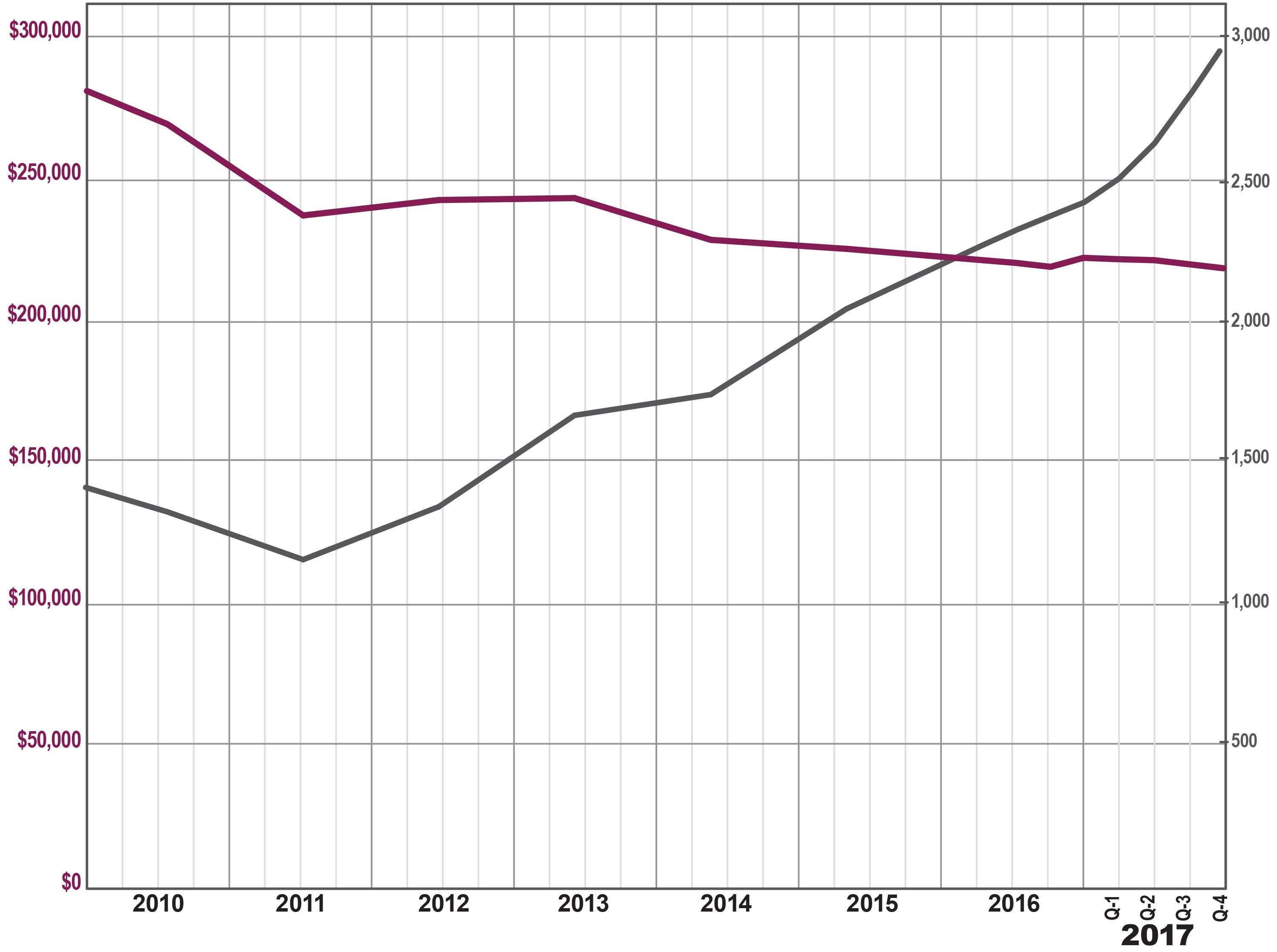
 Activity in the Sussex County housing market surged yet again in the fourth quarter of 2017, with sales up sharply even while prices continued to struggle.
Activity in the Sussex County housing market surged yet again in the fourth quarter of 2017, with sales up sharply even while prices continued to struggle.
Sales. Sussex sales were up yet again in the fourth quarter, rising over 18% from last year and now up over 22% for the year. And the 2,348 sales for the year represented the highest calendar year total in over 10 years. Indeed, Sussex sales have now more than doubled from the bottom of the market in 2011.
Prices. Even with these sustained increases in buyer demand, though, prices continued to struggle. Average prices were down every quarter in 2017 compared to the prior year quarter, falling 2% in the first, 2% in the second, 3% in the third, and now 3% in the fourth. Accordingly, the yearlong price trend was negative, down 2.5% on average and almost 5% at the median. We remain baffled by this, since rising sales and declining inventory would normally drive prices up, not down. But we’ve now seen this trend develop for over a year, so we are skeptical, if hopeful, that prices will turn around in the spring market.
Inventory. The Sussex inventory of available homes for sale fell again, dropping over 35% and now down to about seven months. That’s a significant decline, but inventory is still higher than in other Northern New Jersey counties, which are all below the six‑month inventory line that usually signals the beginning of a seller’s market. If inventory continues to go down, we would expect that to put some additional upward pressure on pricing.
Negotiability. The negotiability metrics indicated that sellers were gaining negotiating leverage with buyers. For the year, the days‑on‑market fell by 14%, dropping by about a month, and sellers were retaining a lot more of their asking price, with listing retention jumping almost two percentage points and now up to over 96%.
Going forward, we expect that Sussex is going to continue to see rising sales. The question is whether this will finally drive some meaningful price appreciation, or at least stem the decline we saw this year. But we remain hopeful that an improving economy, attractive pricing, and near‑historically‑low interest rates will eventually drive prices up in 2018.
To learn more about Better Homes and Gardens Real Estate Rand Realty, visit their website and Facebook page, and make sure to “Like” their page. You can also follow them on Twitter.
Fourth Quarter 2017 Real Estate Market Report: Essex County Overview
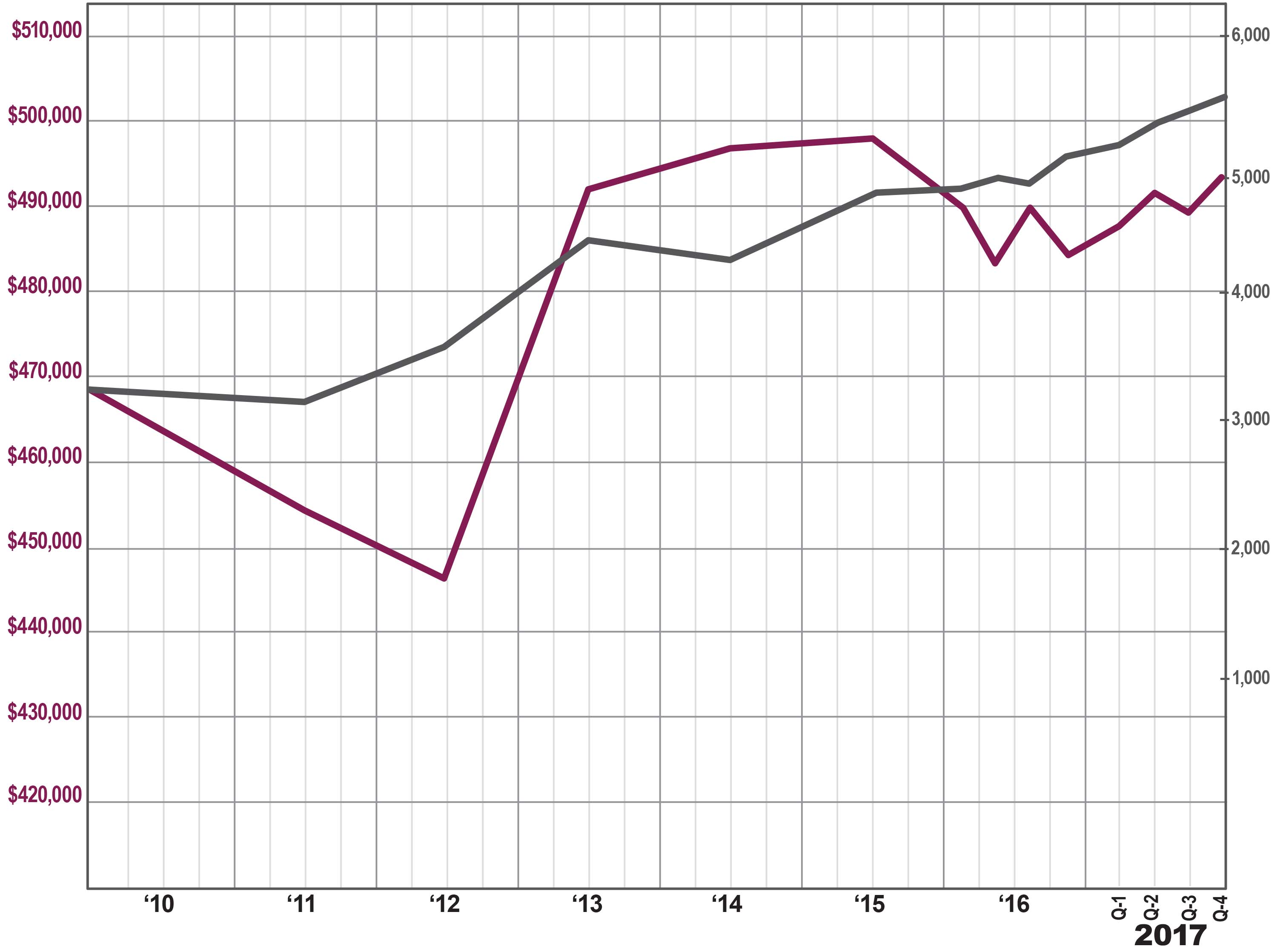
 The Essex County housing finished 2017 strong, with solid increases in both sales and prices.
The Essex County housing finished 2017 strong, with solid increases in both sales and prices.
Sales. Essex sales activity was up again, rising almost 6% from the fourth quarter of last year. And for the full year, sales were up over 8%, hitting over 5,000 sales. This represented the largest yearly total since the height of the seller’s market over 10 years ago, and an increase of almost 70% from the bottom of the market in 2011.
Prices. Essex also started to show some signs of meaningful price appreciation. For the quarter, the average price rose over 5% and the median was up over 4%. More importantly, we saw the first meaningful yearly price appreciation in years, with the average and median both up about 2%. With inventory continuing to fall and buyer demand relatively strong, we would expect prices to gain some momentum throughout 2018.
Inventory. Essex inventory fell again, dropping over 41% from last year’s fourth quarter and now down to just over four months’ worth of available homes. We measure “months of inventory” by calculating the number of months it would take to sell all the available homes at the current rate of absorption, and generally consider anything below six months to signal a seller’s market that would normally drive prices up. So, the fact that Essex is now well below six months would tend to indicate more price appreciation in 2018.
Negotiability. The negotiability indicators – the amount of time sold homes were on the market, and the rate at which sellers were able to retain their full asking price – suggested the sellers might be gaining significant negotiating leverage. Most notably, the listing retention rate crossed the 100% threshold for the third quarter in a row, meaning that Essex homes on average are selling for higher than the listed price. Similarly, the days‑on‑market fell about 11%, and is now down to well under four months of market time. Those are both positive signals of potential future appreciation.
Going forward, we expect that Essex County’s sales activity will continue to drive meaningful price appreciation. With homes still at historically affordable prices, interest rates low, and a generally improving economy, we believe that low inventory levels coupled with stable buyer demand will drive a strong market throughout 2018.
To learn more about Better Homes and Gardens Real Estate Rand Realty, visit their website and Facebook page, and make sure to “Like” their page. You can also follow them on Twitter.
Fourth Quarter 2017 Real Estate Market Report: Morris County Overview
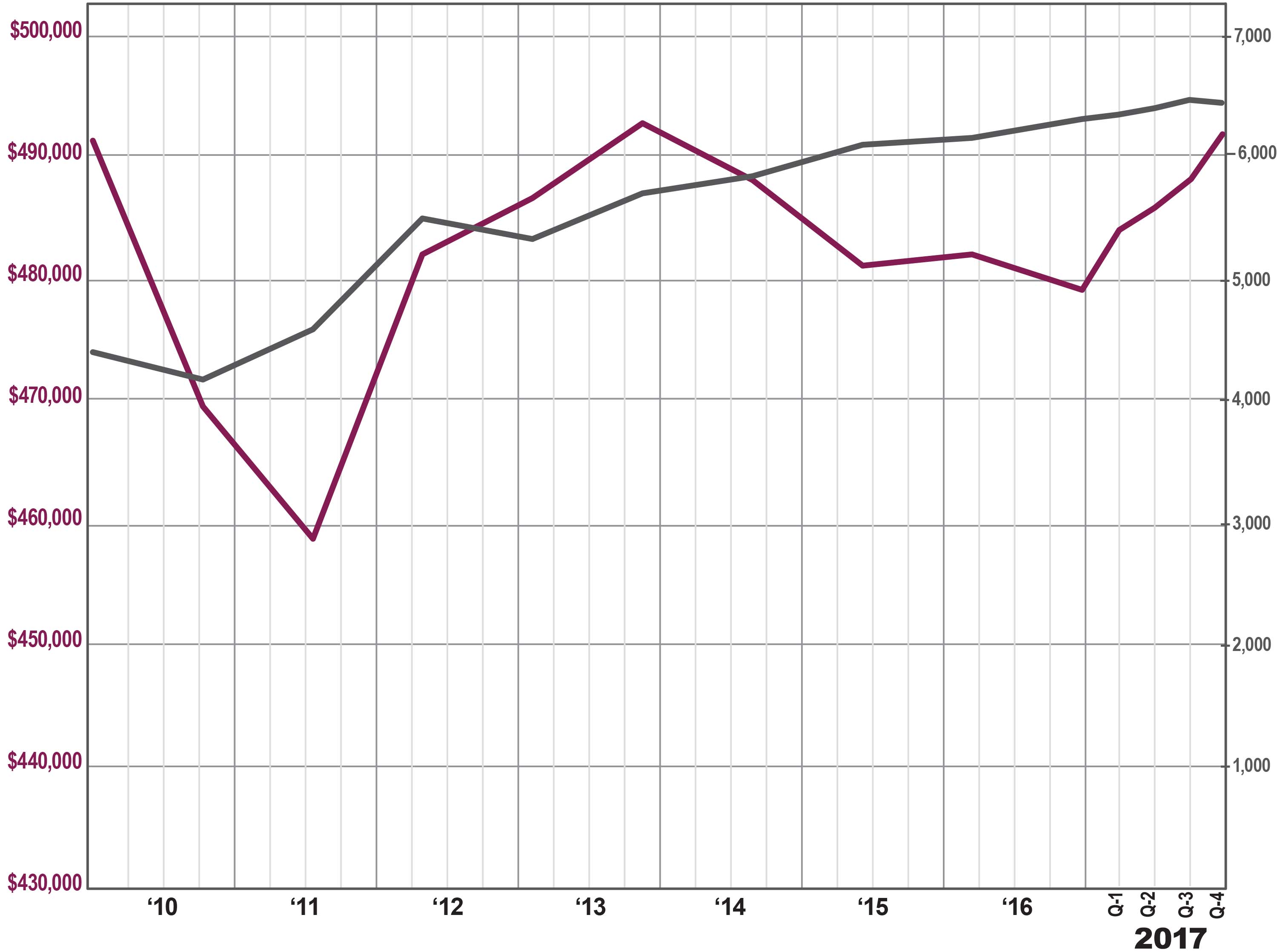
 The Morris County housing market finished 2017 with strong signs of meaningful price appreciation, even while low levels of inventory continued to stifle sales growth.
The Morris County housing market finished 2017 with strong signs of meaningful price appreciation, even while low levels of inventory continued to stifle sales growth.
Sales. Reduced inventory continued to hold back Morris sales growth, with transactions down almost 3% for the quarter, breaking a streak of 12 straight quarters of year‑on‑year sales growth. That said, sales were still up almost 2% for the year, and are now up almost 70% from the bottom of the market in 2011. More significantly, sales are falling not because of a lack of buyer demand, but a lack of available homes for eager buyers to purchase.
Prices. These sustained levels of buyer demand are finally having some modest impact on pricing. Prices were up again in the fourth quarter, rising almost 5% on average and 3% at the median. And we are starting to see long‑term price appreciation, with the 2017 full‑year average price up almost 3% and the median up almost 4%. Sustained levels of buyer demand coupled with falling inventory is likely to continue to drive prices up in 2018.
Inventory. Morris inventory fell again, dropping almost 39% from last year’s fourth quarter and now down to 4.5 months. We measure “months of inventory” by calculating the number of months it would take to sell all the available homes at the current rate of absorption, and generally consider anything below six months to signal a seller’s market that would normally drive prices up. So, the fact that Morris inventory is now well below that six‑month mark indicates that we could be in for some meaningful price appreciation throughout 2018.
Negotiability. The negotiability indicators showed that sellers are continuing to gain negotiating leverage with buyers. For the year, the days‑on‑market were down almost 8%, falling by about 10 days, and the listing retention rate was up almost a full point, now up to almost 98% of the last listed price.
Going forward, we expect that Morris County’s sales activity and low levels of inventory will continue to have a meaningful impact on pricing. With homes still at historically affordable prices, interest rates low, and a generally improving economy, we believe that Morris will enjoy a robust seller’s market in 2018.
To learn more about Better Homes and Gardens Real Estate Rand Realty, visit their website and Facebook page, and make sure to “Like” their page. You can also follow them on Twitter.
Fourth Quarter 2017 Real Estate Market Report: Passaic County Overview
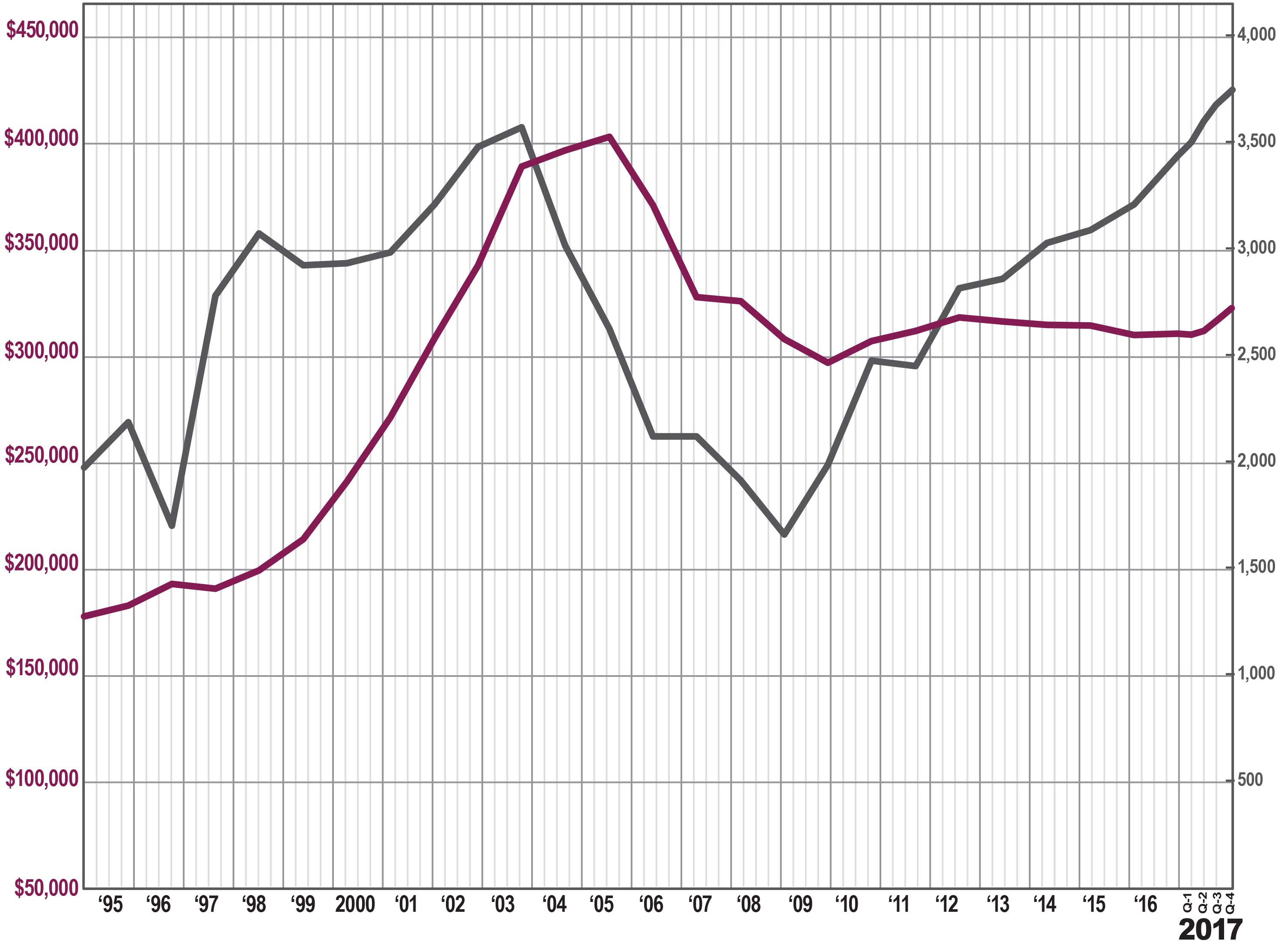
 The Passaic County housing market finished the 2017 year strong, with solid increases in sales and prices, and clear signs of a developing seller’s market.
The Passaic County housing market finished the 2017 year strong, with solid increases in sales and prices, and clear signs of a developing seller’s market.
Sales. Passaic sales were up again in the fourth quarter, rising over 4% and up over 11% for the 2017 calendar year. We’ve now seen sustained increases in buyer demand for over five years, with quarterly sales up in 24 out of the last 26 quarters. As a result, Passaic closed over 3,600 homes in 2017, the highest total we’ve seen since the height of the last seller’s market over 10 years ago.
Prices. More importantly, we’re starting to see these sustained levels of buyer demand have an impact on pricing. Prices were up across the board in the fourth quarter, rising almost 5% on average and at the median. More importantly, the yearlong trend was also positive, with prices up 3% on average and 4% at the median. With buyer demand strong, and inventory falling, we would expect prices to continue to rise.
Inventory. Inventory was down again, falling 41% from last year, and is now down to under five months of inventory. Generally, anything less than six months indicates the start of a seller’s market, and we are now well below that level.
Negotiability. The Passaic negotiability metrics indicated that sellers are continuing to gain leverage over buyers, with homes selling more quickly and for closer to the asking price. Over the past year, the days‑on‑market have fallen over 12%, and are now down to about four months of market time. Similarly, the listing retention rate is up over a full percentage point, now close to 98% of the last listed price. These are both good signs for Passaic sellers.
Going forward, we believe that Passaic’s fundamentals are sound, with homes priced at relatively attractive levels, rates near historic lows, and a stable economy. Accordingly, we expect these levels of buyer demand, coupled with declining inventory, to continue to drive price appreciation throughout a robust 2018.
To learn more about Better Homes and Gardens Real Estate Rand Realty, visit their website and Facebook page, and make sure to “Like” their page. You can also follow them on Twitter.
Fourth Quarter 2017 Real Estate Market Report: Bergen County Overview
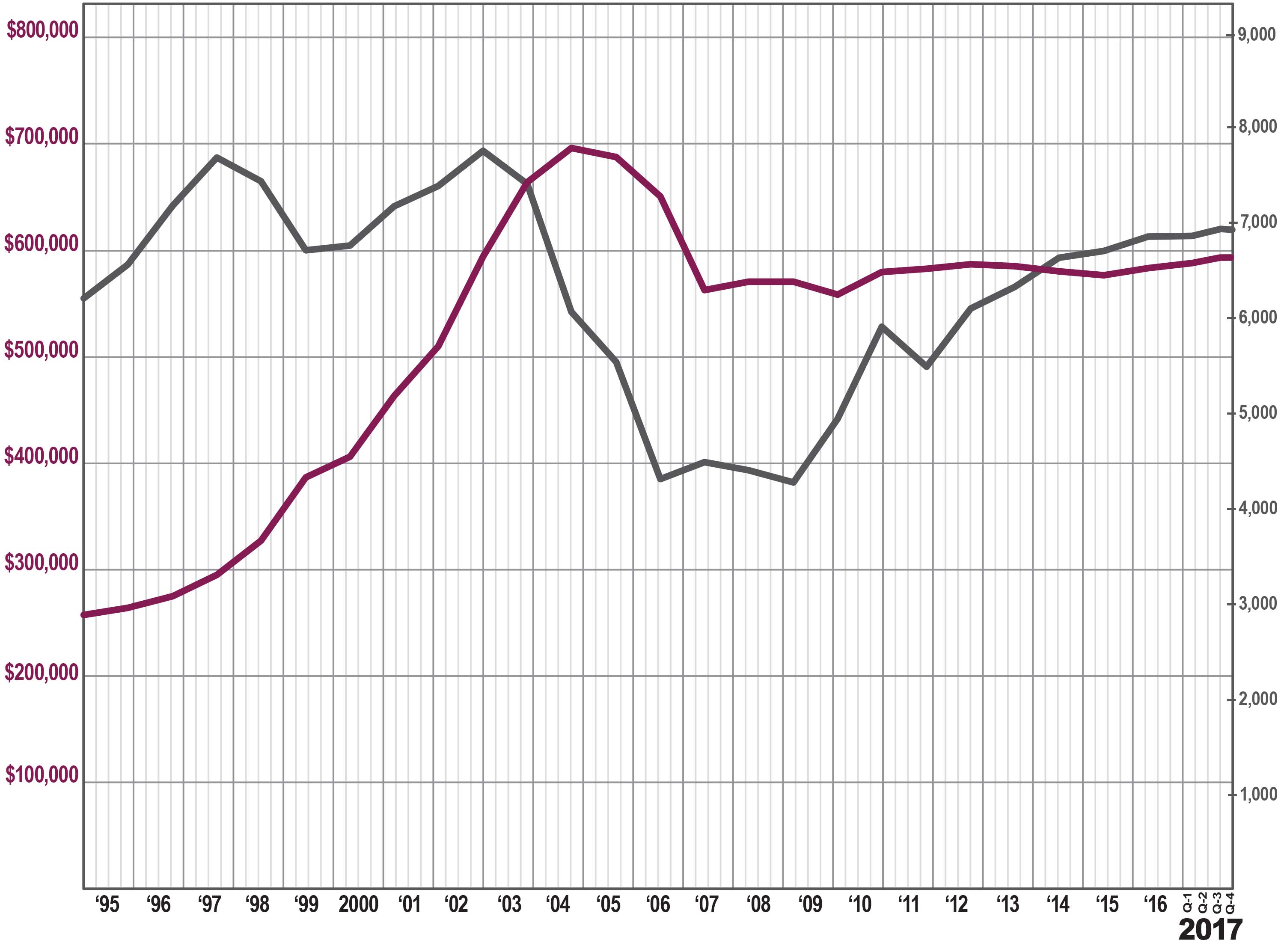
 The Bergen County housing market slowed a bit in the fourth quarter, but still finished the year with meaningful price appreciation and remarkably low inventory levels.
The Bergen County housing market slowed a bit in the fourth quarter, but still finished the year with meaningful price appreciation and remarkably low inventory levels.
Sales. Home sales were down slightly, falling over 4% from the fourth quarter of 2016, which marked the first quarterly decrease in sales in over three years. And for the year, sales were basically flat. That said, the near‑7,000 single‑family sales in 2017 was the highest number of transactions since the height of the last seller’s market over 10 years ago. What’s holding sales back right now is not a lack of demand, but a lack of inventory. If we start seeing more homes hit the market, we’ll see sales go up sharply.
Prices. Single‑family home prices were relatively flat after a torrid third quarter, falling just a tick on average and up about 2% at the median. Over the year, though, we are seeing the impact of declining inventory and strong demand, with prices up about 4% on average and at the median.
Negotiability. All the negotiability indicators are also signaling a rising seller’s market. Inventory continued to tighten in the fourth quarter, with the months of inventory falling almost 5% and now down to well under four months. Anything fewer than six months starts to signal a seller’s market, and we are now way below that level. Similarly, homes are continuing to sell more quickly and for closer to the asking price. As inventory continues to tighten, we would expect to see sellers gain even more negotiating leverage.
Condos. Activity in the Bergen condo market was flat in the fourth quarter, and prices fell about 2%. For the year, sales were up about 5% and prices down just a tick. With inventory now down to about four months, though, we would expect to eventually see some meaningful price appreciation.
Going forward, we expect Bergen County will experience a robust 2018. With inventory tightening, a relatively strong economy, near‑historically‑low interest rates, and prices still at attractive 2004‑05 levels, we believe that sustained buyer demand will continue to drive meaningful price appreciation through the full year. And those rising prices will likely tempt more homeowners into the market, which will drive sales up to even higher levels.
To learn more about Better Homes and Gardens Real Estate Rand Realty, visit their website and Facebook page, and make sure to “Like” their page. You can also follow them on Twitter.
Fourth Quarter 2017 Real Estate Market Report: Northern New Jersey Overview
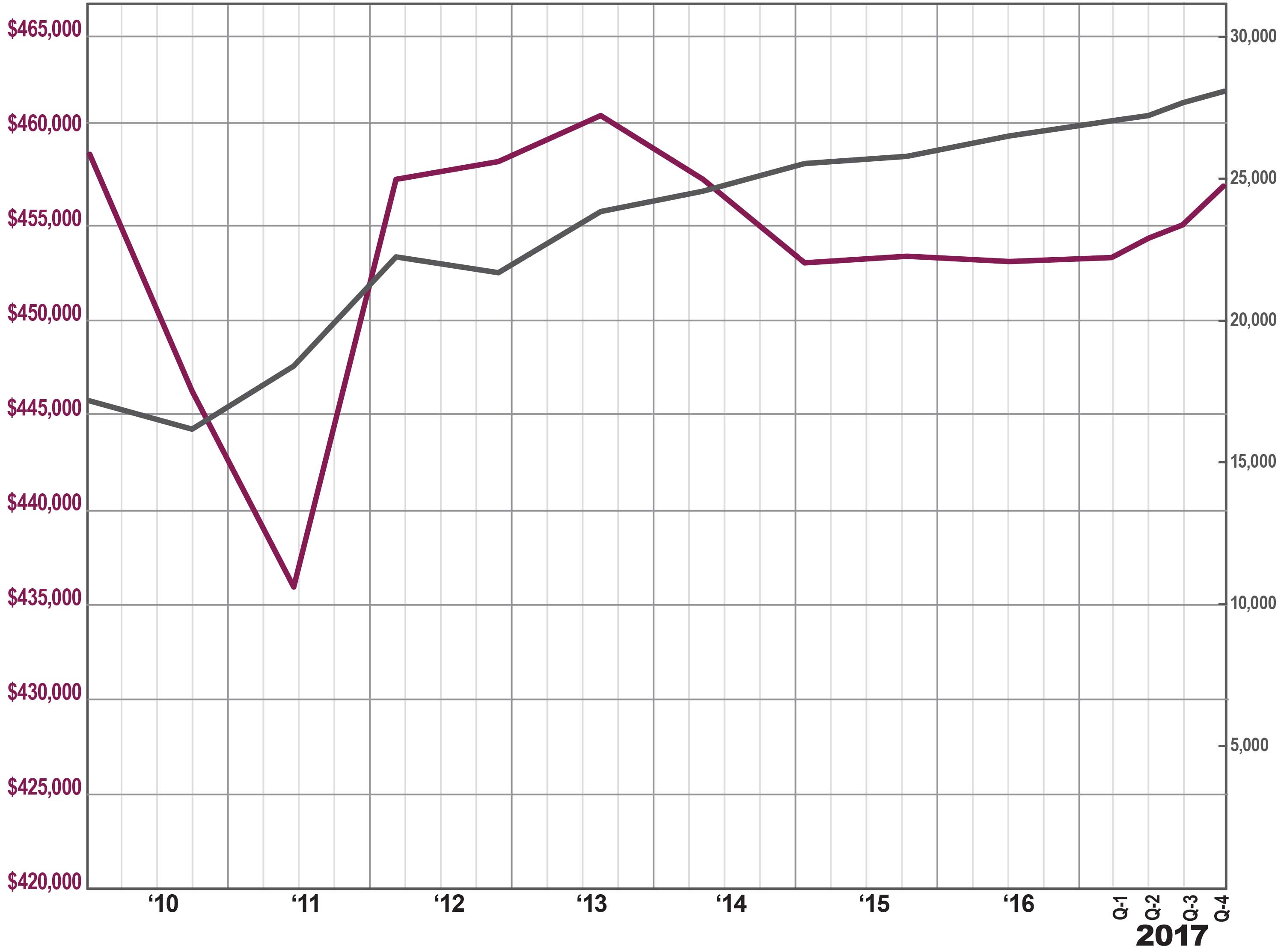
 The Northern New Jersey housing market finished 2017 strong, with prices up even while declining inventory throughout the region stifled sales growth. With demand high, and available homes low, we believe that homeowners will continue to enjoy price increases throughout 2018.
The Northern New Jersey housing market finished 2017 strong, with prices up even while declining inventory throughout the region stifled sales growth. With demand high, and available homes low, we believe that homeowners will continue to enjoy price increases throughout 2018.
Regional sales were up, but not in every county. Regional sales were up slightly for the quarter, rising almost 2% from the fourth quarter of last year, even while some counties like Bergen and Morris were down slightly. We believe that a lack of inventory is stifling sales growth, simply because we don’t have enough “fuel for the fire” to satiate the existing buyer demand. That said, sales in every county were up for the full calendar year, with the 27,000 regional sales in 2017 representing almost a 6% increase from 2016, and a full 75% increase from the bottom of the market in 2011. Inventory was down significantly again. The number of homes for sale continued to fall in the fourth quarter, dropping in every county in the region. Indeed, most of our Northern New Jersey markets have now fallen below the six‑months‑of‑inventory level that traditionally starts to signal a seller’s market: Bergen at 3.4, Passaic at 4.9, Morris at 4.5, and Essex at 4.1. Only Sussex County, at 7.3 months of inventory, is above that six‑month indicator. If inventory continues to tighten, and demand stays strong, we are likely to see more upward pressure on pricing. With sales up and inventory down, prices are starting to show some meaningful price appreciation. Basic economics of supply and demand would tell us that after five years of steadily increasing buyer demand, we would expect to see some meaningful price increases. And we’re starting to see some promising signs: for the 2017 year, the regional average price was up about 1%, and average prices were up in most of the counties in the region: Bergen up 4%, Passaic up 3%, Morris up 3%, Essex up 2%. Again, only Sussex was the outlier, with the average price down about 2%. Going forward, we remain confident that rising demand and falling inventory will continue to drive price appreciation through 2018. Sales have now been increasing for over five years, which has brought inventory below the seller’s market threshold in much of the region. The economic fundamentals are all good: homes are priced at 2004 levels (without even adjusting for inflation), interest rates are still near historic lows, and the regional economy is stable. Accordingly, we continue to believe the region is poised for a robust seller’s market in 2018.
To learn more about Better Homes and Gardens Real Estate Rand Realty, visit their website and Facebook page, and make sure to “Like” their page. You can also follow them on Twitter.
Third-Quarter 2017 Real Estate Market Report: Sussex County Market Overview
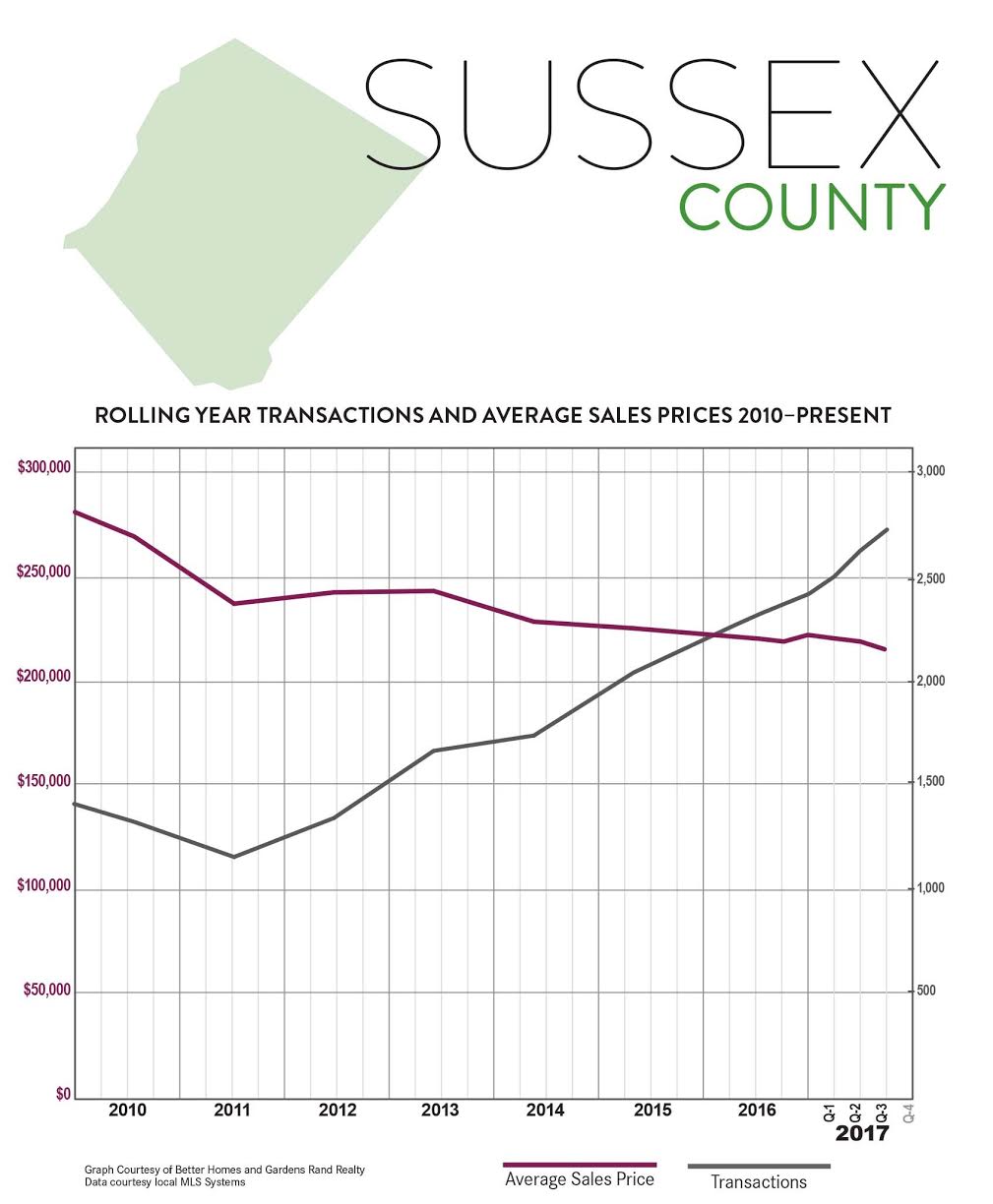
 Activity in the Sussex County housing market surged yet again in the third quarter of 2017, with sales up sharply even while prices continued to struggle.
Activity in the Sussex County housing market surged yet again in the third quarter of 2017, with sales up sharply even while prices continued to struggle.
Sales. Sussex sales were up yet again in the third quarter, rising over 17% from last year and now up over 22% for the year. The 2749 closings represented the highest 12‑month total in over 10 years. Indeed, Sussex sales have now more than doubled from the bottom of the market in 2011.
Prices. Even with these sustained increases in buyer demand, though, prices continued to struggle. We saw some “green shoots” of price appreciation at the end of 2016, with the average price up almost 8% in the fourth quarter. But prices are now down every quarter in 2017, falling 2% in the first, 2% in the second, and now 3% in the third. As a result the rolling year price is basically flat, with the media down just a tick.
Inventory. The Sussex inventory of available homes for sale fell again, dropping 11% and now down to about 10 months. That’s a significant decline, but inventory is still higher than in other Northern New Jersey counties, which are all approaching the six‑month inventory line that usually signals the beginning of a seller’s market. If inventory continues to go down, we would expect that to put some additional upward pressure on pricing.
Negotiability. The negotiability metrics indicated that sellers were gaining negotiating leverage with buyers. The days‑on‑market fell sharply, dropping by almost a month and down now to about four months of market time. And sellers were retaining a lot more of their asking price, with listing retention jumping almost two percentage points and now up to almost 97%.
Going forward, we expect that Sussex is going to continue to see rising sales that will eventually drive meaningful price appreciation. With an improving economy, homes priced at attractive levels, and near‑historically low interest rates, we expect buyer demand coupled with declining inventory to drive a strong fall market and a robust 2018.
To learn more about Better Homes and Gardens Real Estate Rand Realty, visit their website and Facebook page, and make sure to “Like” their page. You can also follow them on Twitter.
Third-Quarter Real Estate Market Report: Essex County Market Overview
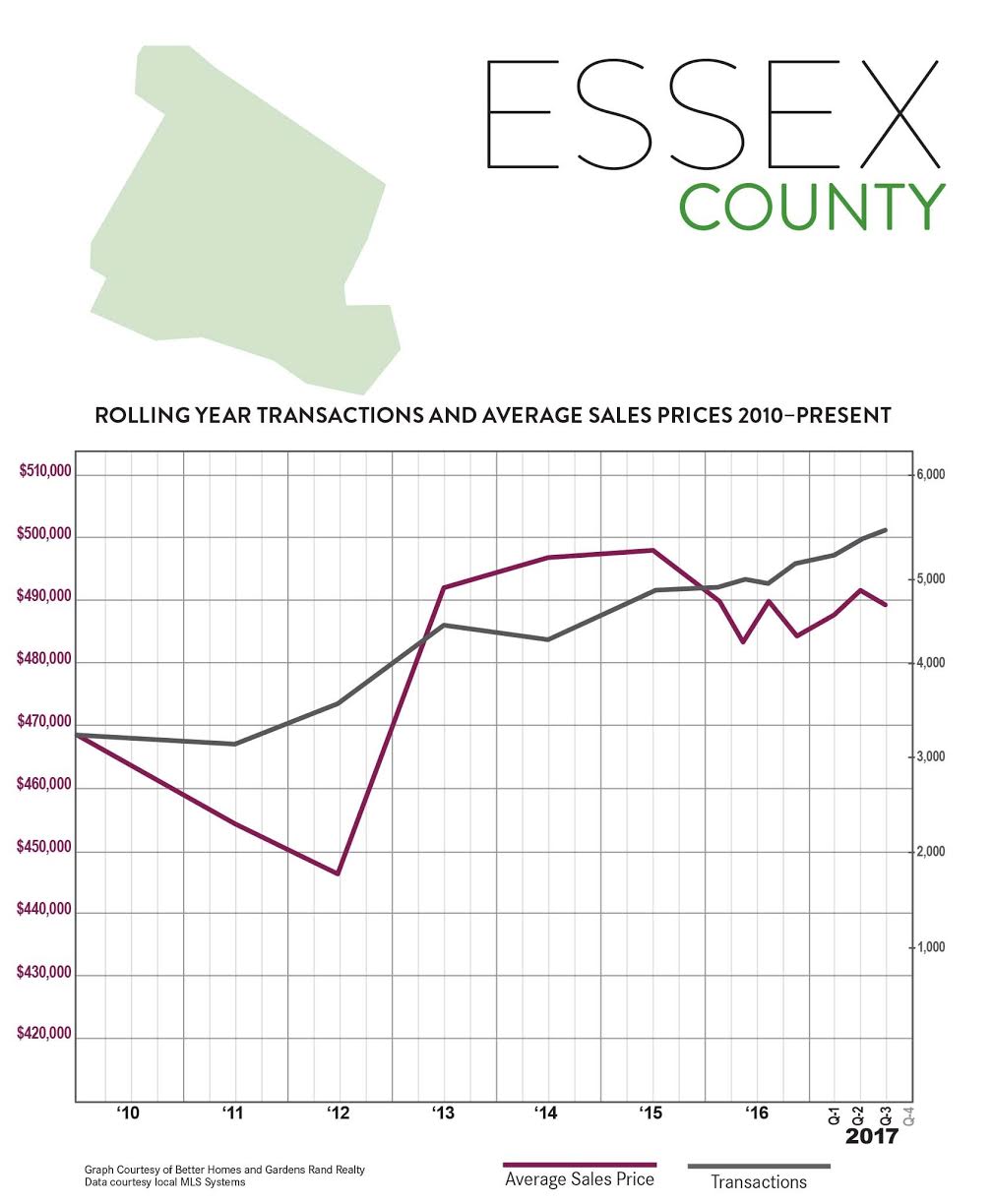
 The Essex County housing market slowed a touch in the third quarter of 2017, with sales up a bit but prices mixed.
The Essex County housing market slowed a touch in the third quarter of 2017, with sales up a bit but prices mixed.
Sales. Essex sales activity was up again, rising almost 4% from the third quarter of last year. This continues a trend that’s been developing for a while, with the rolling year sales up over 9%. Indeed, Essex closed over 5,300 units over the rolling year, the largest 12‑month total since the height of the last seller’s market over 10 years ago, and up almost 70% from the bottom of the market in 2011.
Prices. Pricing, though, was mixed. Even with these sustained increases in buyer demand, the average price was down almost 2% for the quarter, even while the median was up just a tick. We see the same mixed story in the yearlong trends, with the average down just a tick while the median is up about 1%. With inventory continuing to fall and buyer demand relatively strong, we would expect prices to gain some momentum in the fall.
Inventory. Essex inventory fell again, dropping over 29% from last year’s third quarter and now down to just under six months’ worth of available homes. We measure “months of inventory” by calculating the number of months it would take to sell all the available homes at the current rate of absorption, and generally consider anything below six months to signal a seller’s market that would normally drive prices up.
Negotiability. The negotiability indicators – the amount of time sold homes were on the market, and the rate at which sellers were able to retain their full asking price – suggested the sellers might be gaining significant negotiating leverage. Most notably, the listing retention rate crossed the 100% threshold for second quarter in a row, meaning that Essex homes on average are selling for higher than the listed price. Similarly, the days‑on‑market fell about 5%, and is now down to under four months of market time. Those are both positive signals of potential future appreciation.
Going forward, we expect that Essex County’s sales activity will slowly drive some meaningful price appreciation. With homes still at historically affordable prices, interest rates low, and a generally improving economy, we believe that low inventory levels coupled with stable buyer demand will drive a strong market through the rest of 2017.
To learn more about Better Homes and Gardens Real Estate Rand Realty, visit their website and Facebook page, and make sure to “Like” their page. You can also follow them on Twitter.

 Facebook
Facebook
 X
X
 Pinterest
Pinterest
 Copy Link
Copy Link



